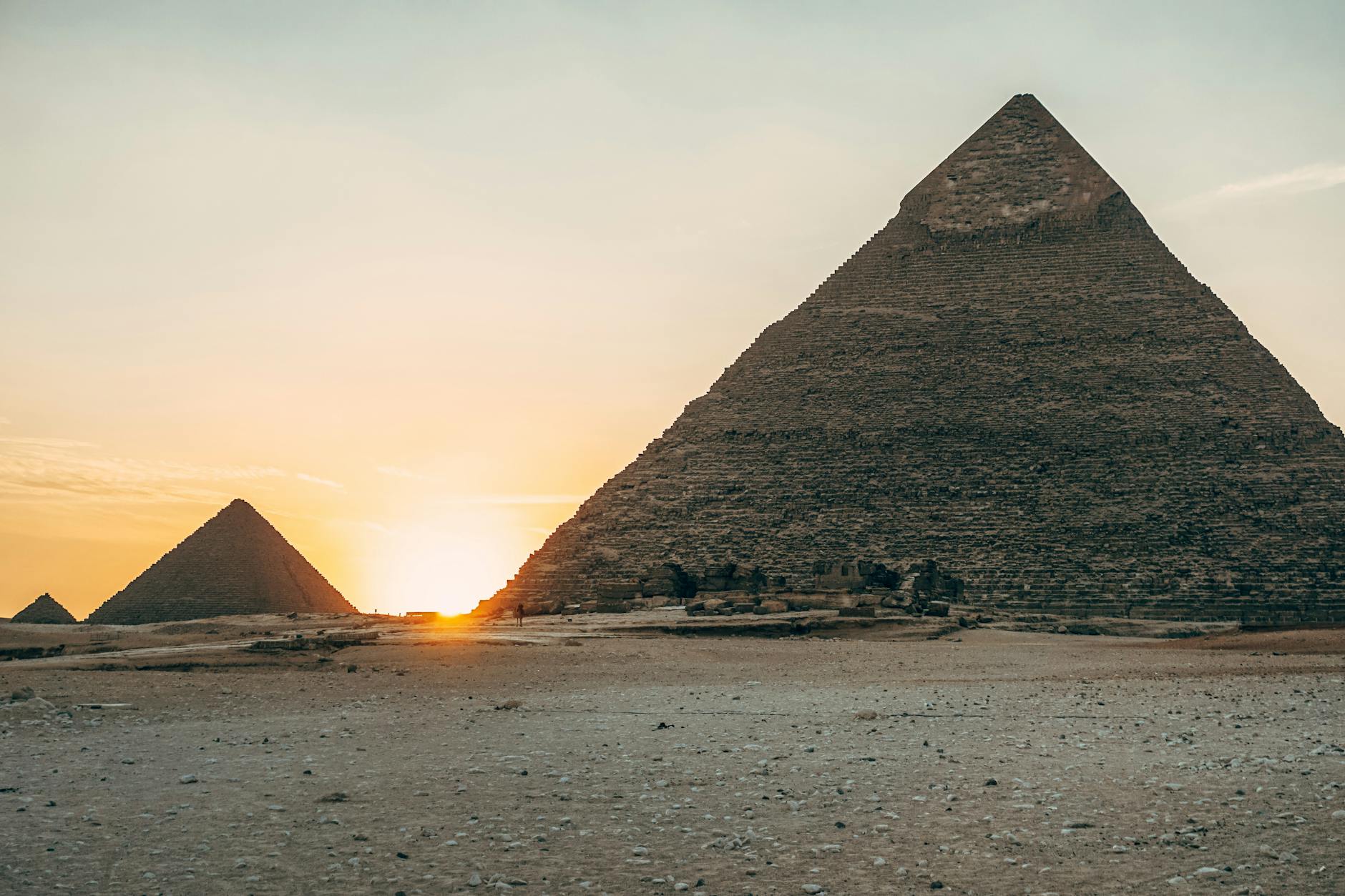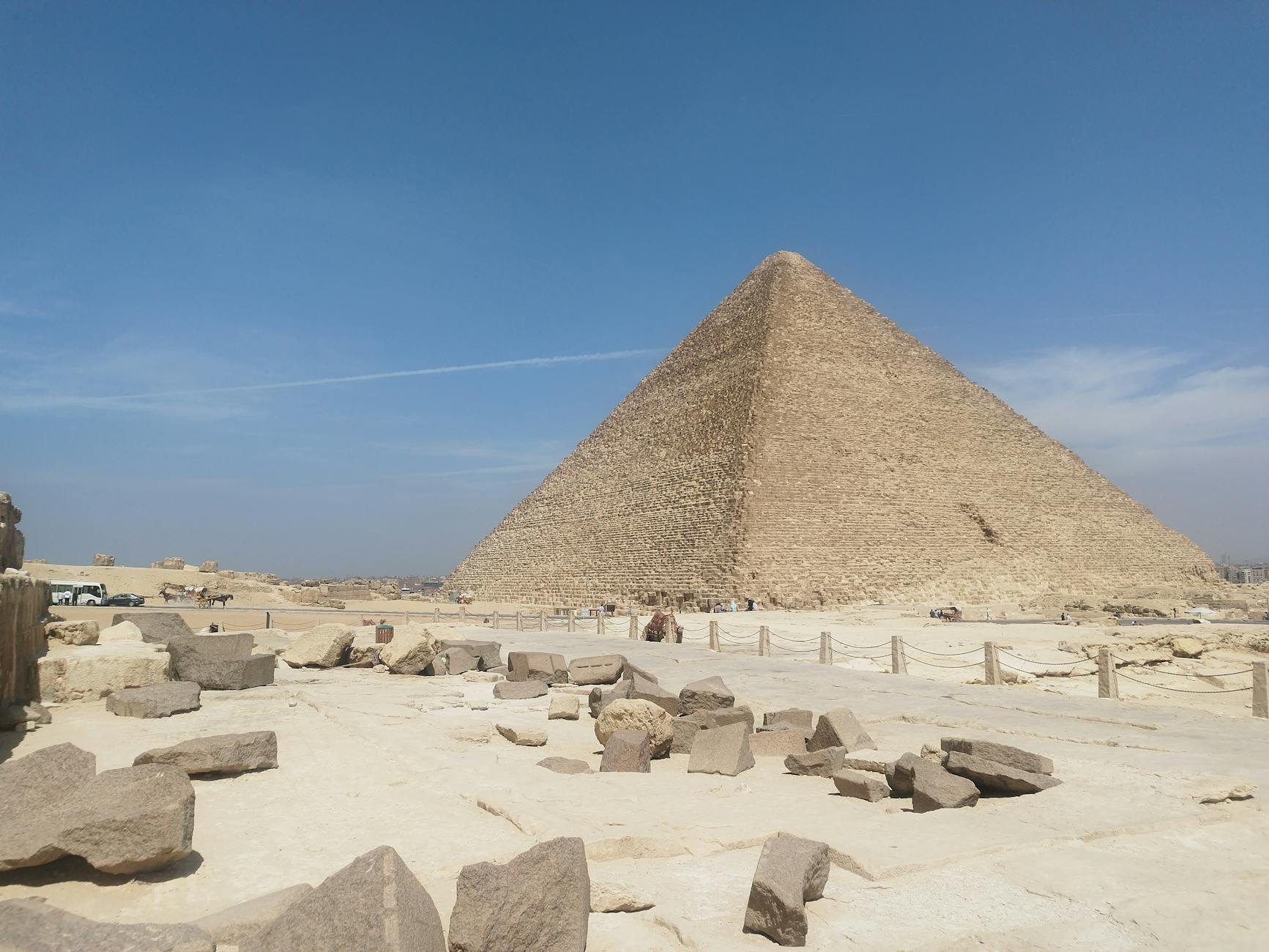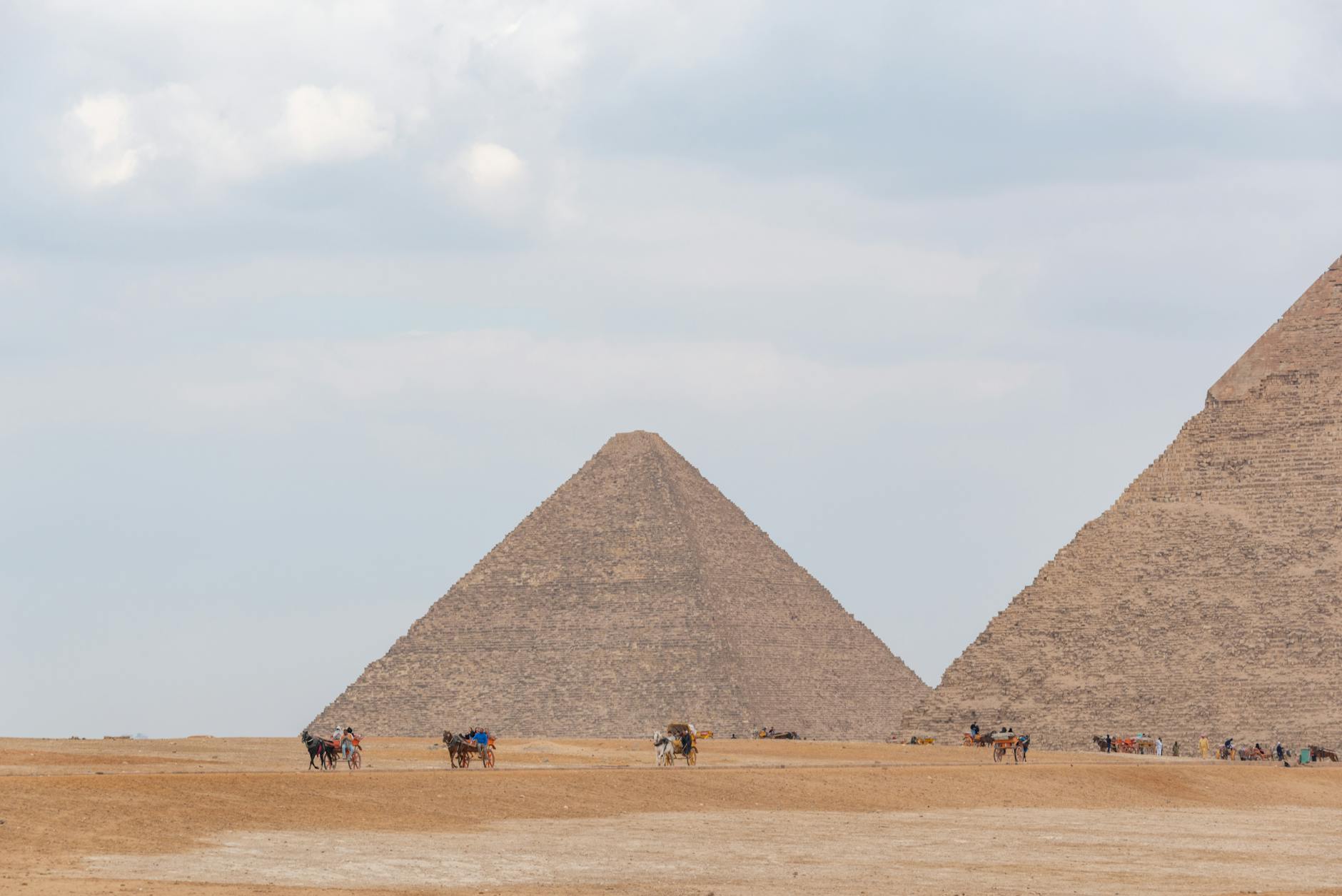Egyptian Pyramids of Giza: History, Architecture, and Preservation in Focus
The Egyptian Pyramids of Giza stand as some of the most impressive structures ever built by humans. They have captured imaginations for thousands of years and remain a powerful symbol of ancient Egypt’s culture and achievements. These massive stone monuments served as tombs for pharaohs and are a testament to skillful engineering and lasting legacy.
Built over 4,500 years ago, the pyramids continue to draw visitors and scholars interested in their history, design, and the mysteries they hold. Understanding their story helps us appreciate the rich heritage of Egypt and the achievements of early civilizations. This post will walk you through their history, architecture, and ongoing efforts to protect these treasures for the future.
Historical Background of the Pyramids of Giza
The Pyramids of Giza aren’t just old buildings; they are monumental symbols of ancient Egypt’s power, faith, and advanced craftsmanship. Understanding when they were built and why adds a deeper layer to their awe-inspiring presence. Let’s look closely at the timeline of their construction and the religious beliefs that shaped their purpose.
Timeline and Builders
The three main pyramids at Giza were constructed during Egypt’s Old Kingdom, specifically the Fourth Dynasty, around 4,500 years ago.
- The Great Pyramid of Khufu (Cheops): Built around 2580–2560 BCE, this is the oldest and largest pyramid. Pharaoh Khufu commissioned it to serve as his tomb. It originally stood at 481 feet tall and was the tallest man-made structure for over 3,800 years.
- Pyramid of Khafre (Chephren): The middle pyramid, built by Khufu’s son, Pharaoh Khafre, around 2550 BCE. It appears taller due to its location on higher ground, but it is slightly smaller than Khufu’s. Khafre’s complex includes the Great Sphinx, carved from a nearby limestone ridge.
- Pyramid of Menkaure: The smallest of the three, this pyramid was constructed by Khafre’s successor, Pharaoh Menkaure, around 2490 BCE. Although smaller, it still reflects the architectural precision and grandeur of the other two.
Each pyramid was part of a larger funerary complex including temples, smaller pyramids for queens, and causeways connecting different elements. These constructions show a clearly planned timeline with shared royal goals across generations.
Purpose and Religious Significance
The pyramids were built as tombs for pharaohs, but their importance stretches far beyond being mere burial sites. In ancient Egyptian beliefs, the pharaoh was a god-king with a divine role to keep order and balance in the world. The pyramids were designed to help the pharaoh’s spirit safely reach the afterlife and join the gods.
- Stairway to Eternity: The pyramid’s shape represented the rays of the sun. Egyptians believed it helped the pharaoh’s soul ascend to the heavens, particularly to join Ra, the sun god.
- Protection of the Body and Soul: Inside each pyramid, elaborate chambers and passageways safeguarded the pharaoh’s body and treasures for the afterlife. These protected the king’s essence from harm and ensured eternal life.
- Symbol of Universal Order: The pyramids also symbolized stability and order in the kingdom. The massive scale and precision reflected the pharaoh’s control over nature and society, reassuring subjects that the cosmos was balanced.
This sacred function made the pyramids a key part of religious and cultural life. They were not just monuments but the heart of ancient Egyptian spiritual vision and royal authority.

Architectural Features and Construction Techniques
The Pyramids of Giza are more than just impressive monuments; they reflect a level of design and engineering that still amazes today. Their planning and building methods show careful thought and skill, especially considering the tools and knowledge available thousands of years ago. Let’s take a close look at what makes these pyramids stand out, starting with the largest one.
The Great Pyramid of Khufu: Design and Dimensions
The Great Pyramid is the crown jewel of the Giza complex. It was built as the tomb for Pharaoh Khufu and is a marvel in size and precision.
- Size and Shape: Originally, the pyramid stood about 481 feet tall (146.6 meters), roughly the height of a modern 40-story building. Its base covers over 13 acres, stretching about 756 feet (230.4 meters) on each side.
- Precise Alignment: The pyramid’s sides are closely aligned to the four cardinal points—north, south, east, and west—with only a tiny margin of error. This kind of accuracy required careful observation of the stars or the sun.
- Layout: Inside, it includes the King’s Chamber, Queen’s Chamber, and a Grand Gallery, all connected by narrow passageways. The chambers are made with massive granite blocks, carefully placed to bear the pyramid’s immense weight.
- Angle: The pyramid’s sides rise at an angle of about 52 degrees, chosen to create its iconic shape. This angle helped balance stability with height.
Imagine fitting millions of stone blocks so perfectly that the seams between some blocks are almost invisible. This precision has helped the pyramid hold up for over 4,500 years.
Materials and Labor
Building the pyramids required more than clever design—it took enormous effort and a well-organized workforce.
- Materials:
- The core blocks were mostly limestone quarried locally.
- The outer casing, now mostly gone, was made from smooth, white Tura limestone, which once gave the pyramid a shining finish.
- Granite used in internal chambers was brought from Aswan, over 500 miles away.
- Workforce:
- Contrary to popular myths about slaves, skilled laborers, craftsmen, and seasonal workers made up the majority of the workforce.
- Teams were organized into crews, each responsible for different tasks: quarrying, transporting stones, setting blocks, and finishing surfaces.
- Estimates suggest that tens of thousands of workers labored on the project, especially during the Nile flood season when farming was impossible.
- Construction Techniques:
- Stones were hauled on sledges, often lubricated with water to reduce friction.
- Ramps built from mudbrick and stone assisted in moving heavy blocks upward as the pyramid rose.
- Exact fitting was achieved through trial and error, using copper tools and abrasive sand to shape stones with surprising accuracy.
The combination of available resources, skilled labor, and smart organization made building these massive structures possible. The effort wasn’t just physical but also required vast knowledge of geometry, astronomy, and project management.
The Great Pyramid stands as a silent record of a civilization that mastered the art of turning stone into a lasting symbol of power and faith.
The Three Main Pyramids and Their Complexes
The Pyramids of Giza are not just three stone monuments standing side by side. Each pyramid comes with its own unique features, designs, and surrounding structures that tell stories about the pharaohs who built them and the culture they lived in. These pyramids are at the heart of bigger complexes that include temples, smaller pyramids, and causeways. Let’s take a closer look at each of the three main pyramids and their fascinating surroundings.
Khufu's Pyramid
Khufu’s pyramid, also known as the Great Pyramid, is the largest and most famous. Its size alone makes it a marvel, but the surrounding complex adds to its importance.
- Size and Structure: Standing originally at 481 feet tall, it’s made of an estimated 2.3 million large limestone blocks. Its base covers more than 13 acres, making it a giant stone masterpiece.
- Mortuary Temple: This temple sat at the pyramid’s eastern side. It was where priests performed rituals and offerings to honor King Khufu and sustain his spirit in the afterlife.
- Causeway: A covered walkway connected the mortuary temple to a valley temple located near the Nile. This 1,000-foot-long passage was likely used for transporting the king’s body and ritual objects.
- Satellite Pyramids: Small pyramids for queens and royals stand nearby, showing how the complex supported the whole royal family’s journey to the afterlife.
- Hidden Chambers: Inside are complex corridors and chambers, including the King’s Chamber made of granite and the mysterious Queen’s Chamber. These inner rooms protected the king’s body and treasures.
Khufu’s pyramid remains the most precise and largest, reflecting the peak of ancient Egyptian engineering and religious belief.

Khafre's Pyramid and the Great Sphinx
Khafre’s pyramid sits close to Khufu’s but stands on higher ground, giving it a towering illusion despite being slightly smaller. Its complex includes one of the most iconic monuments in Egypt—the Great Sphinx.
- The Pyramid: Khafre’s pyramid rises about 448 feet high. Though smaller, its outer casing of smooth white limestone is better preserved, lending it a polished look even today.
- Mortuary Temple and Causeway: Similar to Khufu’s complex, Khafre’s includes a mortuary temple and a long causeway connecting it to the valley temple near the Nile.
- The Great Sphinx: The limestone statue of a lion with a human head is believed to represent Pharaoh Khafre himself. It guards the pyramid complex and symbolizes royal power and protection.
- Symbolism: The Sphinx combines strength and wisdom, reflecting the king’s divine role. Its close proximity shows how Khafre’s complex was designed not just for burial but for spiritual guardianship.
- Valley Temple: Built with huge granite blocks, this temple was crucial for mummification ceremonies and rituals honoring the pharaoh.
Khafre’s pyramid and the Sphinx together create a powerful pair, blending artistry with religious symbolism.
Menkaure's Pyramid
Menkaure’s pyramid is the smallest of the three, but it holds its own unique qualities and shows a different phase in pyramid building.
- Size and Scale: Standing around 213 feet tall, Menkaure’s pyramid is roughly half the height of Khafre’s. It occupies less ground but still impresses with its precision.
- Complex Layout: The pyramid complex includes a mortuary temple like the others but also two smaller pyramids thought to be for queens. The design is simpler but carefully planned.
- Material Variation: Unlike the mostly limestone pyramids of Khufu and Khafre, Menkaure’s incorporates more granite, especially in the lower courses and temple area, which adds durability.
- Decorative Details: The mortuary temple and the valley temple contain statues and artifacts showing Menkaure’s passion for art and his connection to the gods.
- Representation: This pyramid marks a shift toward smaller but still refined royal monuments. It reflects changes in resources and political focus during Menkaure’s reign.
Menkaure’s pyramid stands as a more modest yet refined symbol of royal power and religious devotion, closing the line of the Great Pyramids at Giza.
Together, these three pyramids and their complexes reveal the ancient Egyptians' commitment to honoring their kings and gods, each adding layers of meaning and design to the Giza plateau.
Archaeological Discoveries and Modern Research
The Egyptian Pyramids of Giza have been studied for centuries, but it’s only recently that new tools and discoveries have taken our understanding to the next level. Archaeologists today combine traditional excavation with advanced technology to explore areas once hidden or unreachable. These efforts are uncovering fresh insights into the pyramids' construction, purpose, and the people behind them. Alongside these tech-driven studies, many important artifacts and inscriptions continue to shed light on ancient Egyptian life and beliefs.
Recent Technological Advances in Study
Modern technology is reshaping how researchers investigate the pyramids without causing damage. Techniques like radar scanning and 3D mapping have revealed surprising details about the pyramid structures and the surrounding complex.
- Radar Scanning: Ground-penetrating radar allows experts to peer beneath the surface, revealing hidden chambers and voids without excavation. In 2017, such scans detected a large, unknown cavity inside the Great Pyramid, sparking new theories about its design.
- 3D Mapping: Detailed three-dimensional models of the pyramids help researchers understand the construction process and structural engineering. These maps show tiny differences in stone placement and help digital preservation efforts.
- Thermal Imaging: This method identifies subtle temperature changes on the pyramid’s surface, which can indicate hidden rooms or passageways. By detecting variations in heat retention, thermal scans suggest areas for further exploration.
These tools also help build virtual tours and educational materials, making the pyramids more accessible to people worldwide. Technology brings the past closer than ever, allowing us to "see" what was once locked away or hidden in shadows.

Significant Artifacts and Inscriptions
Artifacts found in and around the pyramids offer rich clues about ancient Egyptian culture, beliefs, and daily life. These objects are valuable records of the people who built and lived near the pyramids.
- Tools and Pottery: Excavations have uncovered copper tools, clay pots, and stone implements used during construction. These finds reveal the working conditions and craftsmanship of that time.
- Funerary Objects: Inside the pyramid complexes, archaeologists found statues, jewelry, and items meant to serve the pharaohs in the afterlife. These artifacts highlight the importance of ritual and the belief in life beyond death.
- Hieroglyphic Inscriptions: Carved texts on walls and artifacts often detail construction records, religious texts, or praises of the pharaohs. These inscriptions help historians reconstruct the ancient Egyptian worldview and practical aspects of pyramid building.
- Worker’s Graffiti: Marks left by labor crews, including team names and tally marks, have been discovered inside hidden chambers. These writings reveal the organization of labor and the pride workers took in their contributions.
These artifacts are not just historical objects; they are storytellers. Each piece adds depth to our understanding of the Egyptians’ skills, beliefs, and social structure during the pyramid-building era.
Together, technology and artifacts form a clearer picture of the Giza pyramids — not just as monuments but as living parts of an ancient society still telling their stories today.
Tourism and Preservation Efforts
The Pyramids of Giza remain a top destination for travelers from across the globe. Millions come to witness their grandeur and walk where history was made. But with great foot traffic comes great responsibility. Balancing visitor experience with the need to protect these ancient monuments is a constant challenge. Let’s explore how tourism shapes the way we experience the pyramids today, and what steps are being taken to preserve them for tomorrow.
Visitor Experience and Guidelines
Visiting the Pyramids of Giza offers a chance to step back in time and marvel at one of the world’s oldest wonders. However, it’s important to keep in mind a few basics to make the visit safe and respectful—to both the site and other tourists.
- Accessibility:
The Giza Plateau is mostly open terrain with uneven sand and stones. Visitors should wear comfortable shoes and be prepared for some walking in hot sun. There is limited wheelchair access due to the nature of the site, so checking ahead with local guides about mobility options is recommended. - Opening Hours and Tickets:
The site is generally open daily from sunrise to sunset. Tickets can be purchased at the entrance or online in advance for convenience. Different tickets cover access to various pyramids and the Solar Boat Museum, so plan ahead depending on what you want to see. - Etiquette and Rules:
- Touching or climbing on the pyramids is strictly prohibited to prevent damage.
- Respect restricted zones marked by barriers or signs.
- Photography is allowed but drone use is banned to protect the site and visitor safety.
- Avoid littering and use designated trash bins to help keep the area clean.
- Engage with local guides for a deeper understanding of the pyramids while supporting the local economy.
- Safety Tips:
Bring water, sun protection, and dress modestly as the site holds cultural sensitivity. Be aware of your surroundings and any animals, such as camels and horses, nearby.
Following these visitor guidelines helps everyone enjoy the mystery and spectacle of the pyramids without harming their delicate surfaces.
Conservation Challenges and Initiatives
The Pyramids of Giza face a series of threats from both nature and human activity. Protecting them is a difficult task that requires ongoing care and strategic action.
Challenges include:
- Environmental Damage:
Pollution and rising humidity from the nearby city of Cairo wear away the limestone surface. Winds and occasional rain also erode exposed stone, accelerating decay. - Foot Traffic Effects:
Heavy tourist traffic can cause wear on pathways and surrounding areas. Unauthorized climbing or touching can chip away precious stone and damage the integrity of the structures. - Urban Encroachment:
Expansion of urban development nearby threatens the site’s buffer zone. Construction, vehicle fumes, and vibrations put pressure on the ancient monuments. - Looting and Vandalism:
Though less common today, illegal excavations and vandalism have damaged parts of the complex in the past.
Preservation Efforts in Place:
- Restoration Projects:
Egyptian authorities and international experts regularly inspect and restore damaged stones. Specialized treatments slow down erosion and reinforce fragile areas. - Visitor Management:
Authorities limit access to sensitive zones and control visitor numbers during peak times. Clear signage and guides help enforce rules that protect the site. - Environmental Controls:
Measures to reduce pollution impacts include restricting motor vehicles nearby and monitoring air quality. Some restoration materials are designed to resist environmental wear. - Research and Monitoring:
Ongoing studies track the pyramids’ condition with lasers, 3D scans, and environmental sensors to catch problems early. This data helps plan focused interventions. - Community Engagement:
Local communities participate in awareness programs promoting respect and protection of the pyramids. Sustainable tourism initiatives aim to balance economic benefits with conservation.
Protecting the Pyramids of Giza requires constant attention and cooperation. Every visitor plays a part by respecting rules and supporting preservation efforts, ensuring future generations can experience these legendary monuments.

Conclusion
The Pyramids of Giza stand as a powerful reminder of human skill and vision from thousands of years ago. They are more than just stone structures; they hold stories about faith, leadership, and culture that shaped ancient Egypt. Their size, design, and the stories they carry continue to inspire curiosity and respect around the world.
Preserving these monuments is key to keeping history alive for future generations. By visiting thoughtfully and supporting conservation, we help protect this timeless treasure. The Pyramids of Giza invite us to appreciate not only their grandeur but also the human spirit behind their creation.











